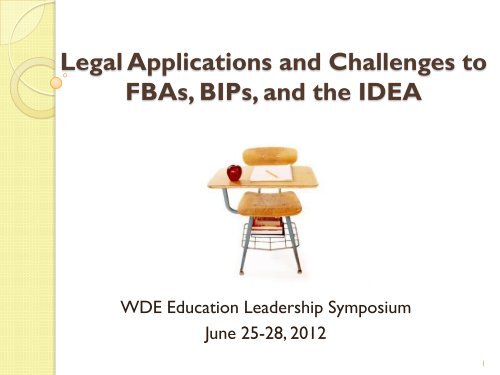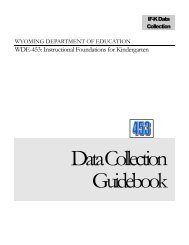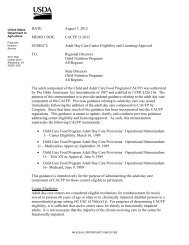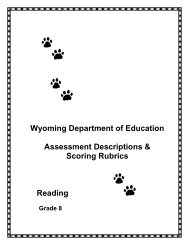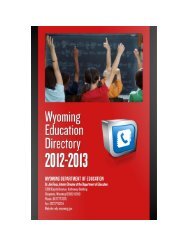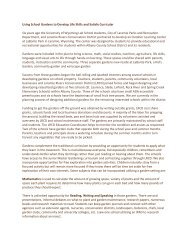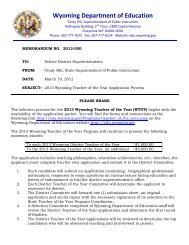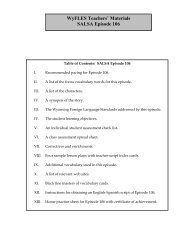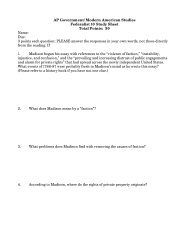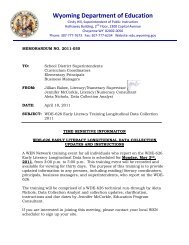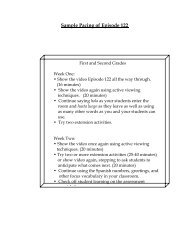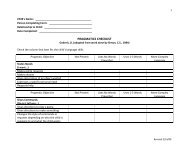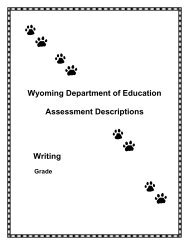Handout - Wyoming Department of Education
Handout - Wyoming Department of Education
Handout - Wyoming Department of Education
Create successful ePaper yourself
Turn your PDF publications into a flip-book with our unique Google optimized e-Paper software.
Legal Applications and Challenges to<br />
FBAs, BIPs, and the IDEA<br />
WDE <strong>Education</strong> Leadership Symposium<br />
June 25-28, 2012<br />
1
Amy J. Goetz<br />
Attorney at Law<br />
452 Selby Avenue<br />
Second Floor East<br />
St. Paul, MN 55102<br />
651.222.6288<br />
agoetz@schoollawcenter.com<br />
DISCLAIMER: This presentation and any accompanying materials are intended as an introduction to<br />
the legal rights <strong>of</strong> students in Minnesota. Nothing in this presentation should be considered legal<br />
advice.<br />
2
General Context<br />
IDEA limits the disciplinary removal <strong>of</strong> students<br />
with disabilities from their current placement<br />
IDEA requires the determination <strong>of</strong> the<br />
relationship between the behavior and disability<br />
to determine a fair placement<br />
3
IDEA Required Consideration <strong>of</strong> the<br />
Use <strong>of</strong> FBAs and BIPs<br />
If the IEP team determines that the child’s<br />
behavior impedes the child’s learning or that <strong>of</strong><br />
others –<br />
◦ The IEP Team must consider the use <strong>of</strong> positive<br />
behavioral interventions and supports, and other<br />
strategies, to address that behavior<br />
34 C.F.R. §300.324(a)(2)(i)<br />
4
IDEA Required Use <strong>of</strong> FBAs and BIPs<br />
If the conduct is a manifestation <strong>of</strong> the disability<br />
the IEP Team must:<br />
◦ Conduct an FBA and implement a BIP; or<br />
◦ If a BIP already exists, then review the BIP and modify<br />
as necessary to address the behavior<br />
34 C.F.R. §300.530(f)<br />
Authority: 20 U.S.C. § 1415(k)(1) and (7) (2011)<br />
5
IDEA Recommended Use <strong>of</strong> FBAs and BIPs<br />
◦ If the child with a disability is removed from<br />
the current placement pursuant to –<br />
Disciplinary changes in placement that would<br />
exceed 10 consecutive school days; or<br />
Possession <strong>of</strong> a weapon or illegal drugs on school<br />
premises, or has inflicted serious bodily injury upon<br />
another person while at school<br />
6
IDEA Recommended Use <strong>of</strong> FBAs and BIPs<br />
◦ The child must receive, as appropriate, a<br />
functional behavioral assessment, and<br />
behavioral intervention services and<br />
modifications, that are designed to address the<br />
behavior violation so that it does not recur<br />
34 C.F.R. 300.530(d)(1)(ii)<br />
7
<strong>Wyoming</strong> <strong>Department</strong> <strong>of</strong> <strong>Education</strong> Interpretation:<br />
In re: Student with a Disability<br />
The <strong>Wyoming</strong> <strong>Department</strong> <strong>of</strong> <strong>Education</strong><br />
(WDE) received a complaint alleging<br />
violations <strong>of</strong> special education law<br />
8
In re: Student with a Disability<br />
Relevant Issues:<br />
◦ Whether the student’s IEP was reasonably<br />
calculated to meet the educational needs <strong>of</strong> the<br />
Student, including a FBA and/or BIP<br />
◦ Whether removing the student from school for<br />
disciplinary reasons resulted in a change <strong>of</strong><br />
placement<br />
9
In re: Student with a Disability<br />
WDE found the following:<br />
◦ Student has a Cognitive Disability<br />
◦ The Student was frequently sent home due to his<br />
behavior<br />
◦ Student’s behavior was impeding his learning and the<br />
learning <strong>of</strong> others.<br />
◦ No evidence <strong>of</strong> a BIP<br />
10
In re: Student with a Disability<br />
WDE came to the following conclusions:<br />
◦ (1) It was incumbent upon the District to address all<br />
educational needs resulting from the Student’s<br />
disability, including his aggressive behavior<br />
11
In re: Student with a Disability<br />
WDE came to the following conclusions:<br />
◦ (2) Despite the fact that the evaluation report<br />
documented that the triggers for the Student’s<br />
behavior were unknown, no further assessment was<br />
undertaken to help appropriately plan for the Student<br />
12
In re: Student with a Disability<br />
WDE came to the following conclusions:<br />
◦ (3) There was no evidence in the file that the behavior<br />
intervention plan was implemented<br />
13
In re: Student with a Disability<br />
WDE came to the following conclusions:<br />
◦ (4) Without a comprehensive evaluation <strong>of</strong> the<br />
student’s needs, the resulting IEPs were not sufficient<br />
to address all <strong>of</strong> his educational needs<br />
14
In re: Student with a Disability<br />
WDE came to the following conclusions:<br />
◦ (5) The District is required to accurately monitor the<br />
number and duration <strong>of</strong> disciplinary removals for the<br />
Student<br />
15
In re: Student with a Disability<br />
WDE came to the following conclusions:<br />
◦ (6) The cumulative total <strong>of</strong> removals resulted in a<br />
pattern <strong>of</strong> removals constituting a change in placement<br />
16
In re: Student with a Disability<br />
WDE came to the following conclusions:<br />
◦ (7) The disciplinary change in placement triggered<br />
additional duties on behalf <strong>of</strong> the District and<br />
safeguards on behalf <strong>of</strong> the Student<br />
17
In re: Student with a Disability<br />
WDE came to the following decisions:<br />
◦ (1) The IEPs were not reasonably calculated to meet<br />
the educational needs <strong>of</strong> the Student<br />
18
In re: Student with a Disability<br />
WDE came to the following decisions:<br />
◦ (2) The district failed to provide special education and<br />
related services to the Student in conformity with his<br />
IEPs due primarily to the repeated practice <strong>of</strong> sending<br />
the Student home as a behavioral consequence<br />
19
In re: Student with a Disability<br />
WDE came to the following decisions:<br />
◦ (3) There was a de facto change <strong>of</strong> placement<br />
20
In re: Student with a Disability<br />
WDE Corrective Action Plan<br />
◦ (1) District must provide an independent evaluation in<br />
order to develop a comprehensive BIP<br />
◦ (2) IEP Team must determine an appropriate BIP<br />
◦ (3) Student shall receive 50 hours <strong>of</strong> compensatory<br />
education<br />
21
In re: Student with a Disability<br />
WDE Corrective Action Plan<br />
◦ (4) The District shall provide 2 hours <strong>of</strong> training to key<br />
special education staff on the use <strong>of</strong> positive BIPs,<br />
removal <strong>of</strong> students for disciplinary reasons, and<br />
writing prior notice<br />
22
Inadequate or Missing FBAs and BIPs:<br />
10 th Judicial Circuit<br />
Ebony S. v. Pueblo School District 60, 819 F.Supp.2d<br />
1179 (D.Colo. 2011)<br />
◦ Student with Down Syndrome was secluded to a<br />
wrap-around desk for apparent misbehavior.<br />
23
Inadequate or Missing FBAs and BIPs:<br />
10 th Judicial Circuit<br />
Ebony S. v. Pueblo School District 60, 819 F.Supp.2d<br />
1179 (D.Colo. 2011)<br />
District Court held that this was not a violation <strong>of</strong> 14 th<br />
Amendment, procedural due process, or equal protection<br />
rights<br />
Fact issues remained as to whether use <strong>of</strong> the table violated<br />
ADA and Rehabilitation Act.<br />
24
Ebony S. v. Pueblo School District 60:<br />
Predicted Outcome<br />
The use <strong>of</strong> the wrap around table constituted a<br />
mechanical restraint<br />
◦ Wrap around desk was used in non-emergency situations<br />
which is a substantial departure from accepted pr<strong>of</strong>essional<br />
practice<br />
Youngberg v. Romeo, 457 U.S. 307, 314 (1982)<br />
◦ Colorado <strong>Department</strong> <strong>of</strong> <strong>Education</strong> states that the only<br />
justification for restraint <strong>of</strong> a school aged child is in an<br />
emergency situations<br />
1 Colo. Code Regs. § 301-45 2620-R- 2.01<br />
25
Ebony S. v. Pueblo School District 60:<br />
Predicted Outcome<br />
Ebony S. has a constitutional right to be free<br />
from bodily restraint under the 14 th<br />
Amendment regardless <strong>of</strong> her disability<br />
◦ Youngberg v. Romeo, 457 U.S. 307, 314 (1982)<br />
District court erred in granting summary<br />
judgment<br />
26
T.W. v. Unified School Dist. No. 259, 136<br />
Fed. Appx. 122 (10 th Cir. 2005)<br />
Student with Down Syndrome sued school<br />
district challenging a hearing <strong>of</strong>ficer’s<br />
determination that the proposed IEP for<br />
the Student complied with IDEA.<br />
27
◦ Facts:<br />
T.W. v. Unified School Dist. No. 259<br />
IEP Team recommended that the Student be<br />
placed in a self-contained classroom for<br />
developmentally disabled children<br />
Student’s parents disagreed and placed the<br />
Student in a regular education classroom<br />
28
◦ Facts:<br />
T.W. v. Unified School Dist. No. 259<br />
In the classroom Student was unable to perform<br />
academic tasks and acted out disturbing others<br />
learning<br />
Teachers concluded that the regular class room<br />
placement was inappropriate for the Student<br />
29
◦ Facts:<br />
T.W. v. Unified School Dist. No. 259<br />
IEP Team reconvened and recommended<br />
placement in a self-contained classroom<br />
Student’s parents would not sign the IEP<br />
Parties engaged in due process hearings before<br />
an IHO<br />
30
T.W. v. Unified School Dist. No. 259<br />
IHO determined that<br />
The proposed placement in a self-contained classroom<br />
met IDEA’s LRE requirement<br />
The IEP was reasonably calculated to provide FAPE<br />
The District had included the appropriate elements in<br />
the inclusion trial placement<br />
District Court granted summary judgment for the<br />
District<br />
31
T.W. v. Unified School Dist. No. 259<br />
◦ Court’s Analysis:<br />
“To the extent plaintiff argues that the BIP is<br />
substantively deficient, he faces an uphill battle. Neither<br />
the IDEA nor its implementing regulations prescribe<br />
any specific substantive requirements for a BIP.”<br />
32
T.W. v. Unified School Dist. No. 259<br />
◦ Court’s Analysis:<br />
Courts should be leery <strong>of</strong> creating such substantive<br />
requirements<br />
Plaintiff fails to show that the BIP was an inadequate<br />
accommodation<br />
33
T.W. v. Unified School Dist. No. 259<br />
◦ Court’s Analysis:<br />
Evidence shows that the District did propose<br />
modifications to the plan, but the District could not<br />
implement the modification because it did not have<br />
consent from the Student’s parents<br />
Proposed placement did not violate IDEA’s LRE<br />
provision<br />
34
T.W. v. Unified School Dist. No. 259<br />
◦ Court’s Analysis:<br />
Student was not denied FAPE<br />
Judgment affirmed<br />
T.W. v. Unified School Dist. No. 259, 136 Fed. Appx. 122<br />
(10 th Cir. 2005)<br />
35
Legal Challenges to FBAs and BIPs:<br />
Lack <strong>of</strong> Legal Standard<br />
T.W. references a 7 th Circuit decision:<br />
◦ Alex R. by Beth R. v. Forrestville Valley Community Unit. Sch.<br />
Dist. No. 221, 104 LRP 33610 (7 th Cir. 2004)<br />
◦ Court recognized that there is no set legal standard<br />
for an FBA or BIP<br />
36
Legal Challenges to FBAs and BIPs:<br />
Lack <strong>of</strong> Legal Standard<br />
T.W. references a 7 th Circuit decision:<br />
“In short, the District’s behavioral intervention plan<br />
could not have fallen short <strong>of</strong> substantive criteria<br />
that do not exist, and so we conclude, as a matter <strong>of</strong><br />
law it was not substantively invalid under the IDEA.”<br />
37
Legal Challenges to FBAs and BIPs:<br />
Lack <strong>of</strong> Legal Standard<br />
7 th Circuit referred to Letter to Janssen, 51 IDELR 253<br />
(OSEP 2008):<br />
When asked what an FBA is and should consist <strong>of</strong> and<br />
who can or must conduct the FBA, OSEP responded:<br />
“Part B <strong>of</strong> the IDEA and the Part B regulations do not<br />
specifically explain what an FBA is or what components<br />
must be included in an FBA… The statue and<br />
regulations do not specify which individuals must<br />
conduct the FBA.”<br />
38
Legal Challenges to FBAs and BIPs:<br />
Lack <strong>of</strong> Legal Standard<br />
BUT WHEN YOU READ THE FULL LETTER…<br />
39
Legal Challenges to FBAs and BIPs:<br />
Lack <strong>of</strong> Legal Standard<br />
“Schools are expected to have properly trained<br />
pr<strong>of</strong>essionals available to conduct FBAs and to<br />
provide positive behavioral interventions and<br />
supports. It is the LEA’s responsibility, working<br />
with the state department <strong>of</strong> education, to<br />
provide pr<strong>of</strong>essional development, in servicing<br />
training, and technical assistance, as needed, for<br />
school staff members to be able to conduct an<br />
FBA and provide positive behavioral interventions<br />
and supports”<br />
Letter to Janssen, 51 IDELR 253 (OSEP 2008)<br />
40
T.W. v. Unified School Dist. No. 259:<br />
Things to Consider<br />
There is a substantive standard<br />
41
T.W. v. Unified School Dist. No. 259:<br />
Things to Consider<br />
Look at the context <strong>of</strong> the law<br />
◦ One purpose <strong>of</strong> IDEA is to assess, and ensure the<br />
effectiveness <strong>of</strong> efforts to educate children with<br />
disabilities<br />
20 USC §1400(d)(4)<br />
42
T.W. v. Unified School Dist. No. 259:<br />
Things to Consider<br />
Why have a law with no means to achieve the<br />
purpose?<br />
43
T.W. v. Unified School Dist. No. 259:<br />
Things to Consider<br />
The words tell us the standard<br />
◦ “In the case <strong>of</strong> a child whose behavior impedes the child's<br />
learning or that <strong>of</strong> others, consider the use <strong>of</strong> positive<br />
behavioral interventions and supports, and other strategies,<br />
to address that behavior.”<br />
20 USC §1414(d)(3)(B)(i)<br />
44
T.W. v. Unified School Dist. No. 259:<br />
Things to Consider<br />
The words tell us the standard<br />
◦ “A child with a disability who is removed from the child's<br />
current placement . . . shall . . . receive, as appropriate, a<br />
functional behavioral assessment, behavioral intervention<br />
services and modifications, that are designed to address the<br />
behavior violation so that it does not recur.”<br />
20 USC §1415(k)(1)(D)<br />
45
T.W. v. Unified School Dist. No. 259:<br />
Things to Consider<br />
The words tell us the standard<br />
◦ “[T]he IEP Team shall . . . conduct a functional behavioral<br />
assessment, and implement a behavioral intervention plan<br />
for such child, provided that the local educational agency<br />
had not conducted such assessment prior to such<br />
determination before the behavior that resulted in a<br />
change in placement.”<br />
20 USC §1415(k)(1)(F)<br />
46
T.W. v. Unified School Dist. No. 259:<br />
Things to Consider<br />
The standard is meant to address the behavior,<br />
through the use <strong>of</strong> FBAs and BIPs, so that the<br />
behavior does not<br />
◦ (1) impede the learning <strong>of</strong> the child or others; and<br />
◦ (2) does not recur<br />
47
How is This Standard in Practice in<br />
<strong>Wyoming</strong>?<br />
48
Seclusion and Restraint in Schools<br />
<strong>Wyoming</strong> <strong>Department</strong> <strong>of</strong> <strong>Education</strong> – Chapter 42<br />
– Section 3 states:<br />
◦ Each student has a right to be free from seclusion or<br />
restraint used as a means <strong>of</strong> coercion, punishment,<br />
convenience, or retaliation<br />
◦ Seclusion and restraint are not instructions tools for the<br />
development <strong>of</strong> prosocial behavior<br />
49
Seclusion and Restraint in Schools<br />
◦ Proactive and preventive<br />
behavior interventions should<br />
be initiated and ongoing to<br />
diffuse disruptive and volatile<br />
situations<br />
50
Evaluation Procedures<br />
In conducting the evaluation, the<br />
public agency must:<br />
◦ (1) Use a variety <strong>of</strong> assessment<br />
tools and strategies to gather<br />
relevant functional, developmental,<br />
and academic information<br />
34 C.F.R. § 300.304(b)(1)<br />
51
Evaluation Procedures<br />
In conducting the evaluation, the public agency<br />
must:<br />
◦ (2) Not use any single measure or assessment as the sole<br />
criterion<br />
34 C.F.R. § 300.304(b)(2)<br />
◦ (3) Use technically sound instruments that may assess<br />
the relative contribution <strong>of</strong> cognitive and behavioral<br />
factors<br />
34 C.F.R. § 300.304(b)(3)<br />
52
When Should an FBA be Conducted?<br />
• Even when the behavior will not result in a change<br />
<strong>of</strong> placement, the behavior should be addressed if it<br />
is interfering with the child’s education or that <strong>of</strong><br />
others<br />
• The Act emphasizes a proactive approach to<br />
behaviors that interfere with learning<br />
53
When Should an FBA be Conducted?<br />
• “This provision should ensure that children who<br />
need behavior intervention plans to succeed in<br />
school receive them.”<br />
71 Federal Register 46721 (2006)<br />
54
Special Considerations Section <strong>of</strong> the<br />
IEP<br />
Directs IEP Team’s attention to the potential<br />
behavioral needs <strong>of</strong> the Student<br />
The IEP Team must:<br />
◦ Consider the use <strong>of</strong> positive behavioral interventions<br />
and supports<br />
55
Strategies for Compliance<br />
An FBA and BIP should be provided when:<br />
◦ The Student is suspended in excess <strong>of</strong> 10 days during<br />
the school year; or<br />
◦ The Student is recommended for expulsion<br />
◦ The Student is placed in a 45-school-day interim<br />
alternative educational placement<br />
56
Strategies for Compliance<br />
An FBA and BIP should be provided when:<br />
◦ A manifestation determination review is conducted<br />
and results in a finding <strong>of</strong> relatedness<br />
◦ The IEP Team recommends a more restrictive<br />
placement<br />
Donald Y. Yu, Discipline Dilemmas: Your Guide to Avoiding to Top IDEA and<br />
Section 504 Mistakes (2009)<br />
57
Suggestions for Best Practices<br />
Have written documentation <strong>of</strong> the FBA<br />
◦ The IDEA does not expressly require that an FBA be<br />
in writing. Board <strong>of</strong> Educ. <strong>of</strong> the Akron Cent. Sch. Dist., 28<br />
IDELR 909 (SEA NY 1998).<br />
58
Suggestions for Best Practices<br />
Develop, review, implement, and document the<br />
BIP as a part <strong>of</strong> the IEP process<br />
◦ 71 Fed. Reg. 46,721 (2006)<br />
◦ John M. v. Board <strong>of</strong> Educ. <strong>of</strong> Evanston Cmty. Consol. Sch. Dist. 65, 37 IDELR<br />
38 (N.D. Ill. 2002); Santa Fe Pub. Schs., 36 IDELR 52 (SEA NM 2001); and<br />
Eastern Lebanon County Sch. Dist., 34 IDELR 190 (SEA PA 2000).<br />
59
Suggestions for Best Practices<br />
Be proactive in deciding when to conduct an<br />
FBA<br />
◦ FBAs and behavior intervention plans are not required<br />
components <strong>of</strong> the IEP under 34 CFR 300.320.<br />
71 Fed. Reg. 46629 (2006)<br />
60
Suggestions for Best Practices<br />
Identify and define behaviors in terms that are<br />
specific, observable, and measurable<br />
◦ Minnesota <strong>Department</strong> <strong>of</strong> <strong>Education</strong>, “Addressing Challenging Student<br />
Behavior: Functional Behavior Assessment and Positive Behavioral<br />
Support.”<br />
61
Suggestions for Best Practices<br />
Consider cultural factors in evaluating behavior.<br />
Students may respond to acculturation by<br />
demonstrating different forms <strong>of</strong> behavior.<br />
◦ IE: use culturally neutral questions during assessment, ask about prior<br />
experiences in schools<br />
◦ Minnesota <strong>Department</strong> <strong>of</strong> <strong>Education</strong>, “Addressing Challenging Student<br />
Behavior: Functional Behavior Assessment and Positive Behavioral<br />
Support.”<br />
◦ Minnesota <strong>Department</strong> <strong>of</strong> <strong>Education</strong>, “Reducing Bias in Special <strong>Education</strong><br />
Assessment.” (1998).<br />
62
Suggestions for Best Practices<br />
Develop a realistic and specific plan <strong>of</strong> action in<br />
the BIP<br />
63
Suggestions for Best Practices<br />
Develop a realistic and specific plan <strong>of</strong> action in<br />
the BIP<br />
64
Suggestions for Best Practices<br />
Disciplinary sanctions should be consistent with<br />
the intervention strategies set out in the<br />
student's BIP<br />
◦ Cabarrus County (NC) Sch. Dist., 22 IDELR 506 (OCR 1995).<br />
65
Suggestions for Best Practices<br />
The decision is ultimately with the IEP team to<br />
determine a student's need for a BIP<br />
◦ 71 Fed. Reg. 46,683 (2006).<br />
66
Suggestions for Best Practices<br />
In other words, it just has to work<br />
Teachers, students, parents, and administrators<br />
ALL benefit from effective plans to address<br />
behavior<br />
67
Comments or Questions?<br />
Amy Goetz<br />
School Law Center<br />
(651) 222-6288<br />
agoetz@schoollawcenter.com<br />
68


